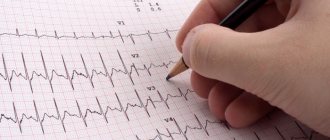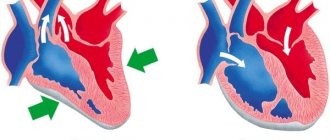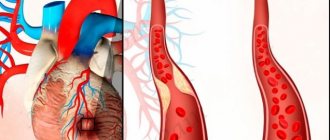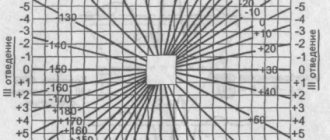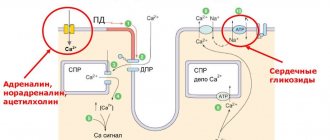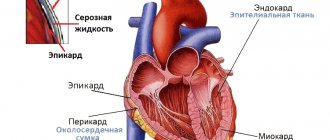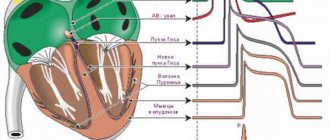Anterior rotation of the heart apex on ECG
1. Horizontal direction of the electrical axis of the heart (the vector axis is parallel to standard lead I). In Fig. 28 presents an analysis of the formation of an ECG with this variant of the position of the electrical axis of the heart.
Rice. 28. Horizontal position of the electrical axis of the heart ( = from 0° to +29°). Visual signs: RI > RII > RIII; SIII > RIII; RaVF = SaVF.
2. The normal direction of the electrical axis of the heart (the vector axis is parallel to the axis of lead II) is shown in Fig. 29.
Rice. 29. Normal position of the electrical axis of the heart ( = from +30° to +69°). Visual signs: RII > RI > RIII.
3. The vertical position of the electrical axis of the heart (the vector axis is perpendicular to the axis of lead I) is shown in Fig. thirty.
Rice. 30. Vertical position of the electrical axis of the heart ( from +70° to +90°). Visual signs: RII = RIII > RI; RI = SI.
4. Deviation of the electrical axis of the heart to the left (the vector axis is most parallel to standard lead I) is shown in Fig. 31.
Rotation of the heart by the right ventricle
When the heart rotates clockwise around its longitudinal axis (as viewed from the apex), the right ventricle moves forward and upward, and the left ventricle moves backward and downward. This position is a variant of the vertical position of the heart axis. In this case, a deep Q wave appears on the ECG in lead III, and occasionally in lead aVF, which can simulate signs of focal changes in the posterior phrenic region of the left ventricle.
At the same time, a pronounced S wave is detected in leads I and aVL (the so-called QIII SI syndrome). There is no q wave in leads I, V5 and V6. The transition zone may shift to the left. These changes also occur with acute and chronic enlargement of the right ventricle, which requires appropriate differential diagnosis.
The figure shows an ECG of a healthy 35-year-old woman with an asthenic build. There are no complaints about dysfunction of the heart and lungs. There is no history of diseases that could cause hypertrophy of the right heart. Physical and x-ray examination revealed no pathological changes in the heart and lungs.
The ECG shows the vertical position of the atrial and ventricular vectors. Â P = +75°. Â QRS = +80°. Noteworthy are the pronounced q waves along with tall R waves in leads II, III and aVF, as well as S waves in leads I and aVL. Transition zone in V4-V5. The indicated ECG features could provide grounds for determining hypertrophy of the right heart, but the absence of complaints, anamnesis data, and the results of clinical and X-ray examinations allowed us to exclude this assumption and consider the ECG to be a normal variant.
The rotation of the heart around the longitudinal axis counterclockwise (i.e., with the left ventricle forward and upward), as a rule, is combined with deviation of the apex to the left and is a rather rare variant of the horizontal position of the heart. This variant is characterized by a pronounced Q wave in leads I, aVL and left chest along with pronounced S waves in leads III and aVF. Deep Q waves may mimic signs of focal changes in the lateral or anterior wall of the left ventricle. The transition zone with this option is usually shifted to the right.
A typical example of this variant of the norm is the ECG shown in the figure of a 50-year-old patient with a diagnosis of chronic gastritis. This curve shows a pronounced Q wave in leads I and aVL and a deep S wave in lead III.
“Practical electrocardiography”, V.L. Doshchitsin
In some cases, variants of a normal ECG associated with different positions of the heart axis are mistakenly interpreted as a manifestation of one or another pathology. In this regard, we will first consider the “positional” variants of a normal ECG. As mentioned above, healthy people may have a normal, horizontal or vertical position of the electrical axis of the heart, which depends on body type, age and...
A normal ECG with a horizontal position of the electrical axis of the heart must be distinguished from signs of left ventricular hypertrophy. When the electrical axis of the heart is vertical, the R wave has a maximum amplitude in leads aVF, II and III; in leads aVL and I, a pronounced S wave is recorded, which is also possible in the left chest leads. ÂQRS = + 70° – +90°. Such...
Posterior rotation of the heart is accompanied by the appearance of a deep S1 wave in leads I, II and III, as well as in lead aVF. A pronounced S wave may also be observed in all chest leads with a shift of the transition zone to the left. This variant of a normal ECG requires differential diagnosis with one of the ECG variants for right ventricular hypertrophy (S-type). The picture shows...
Premature or early repolarization syndrome is a relatively rare variant of a normal ECG. The main symptom of this syndrome is ST segment elevation, which has a peculiar shape of a convex downward arc and begins from a high J point on the descending knee of the R wave or on the terminal part of the S wave. A notch at the point of transition of the QRS complex to the descending ST segment ...
Rotation of the heart of the right ventricle forward: diet, signs and treatment, prevention, herbs
Have you been struggling with HYPERTENSION for many years without success?
Head of the Institute: “You will be amazed at how easy it is to cure hypertension by taking it every day...
Read more "
Left ventricular (LV) hypertrophy implies an increase in its cavity and walls due to internal or external negative factors.
These usually include hypertension, nicotine and alcohol abuse, but moderate pathology sometimes occurs in people who play sports and are regularly exposed to heavy physical activity.
OUR READERS RECOMMEND!
Our readers successfully use ReCardio to treat hypertension. Seeing how popular this product is, we decided to bring it to your attention. Read more here...
Norms of myocardial parameters
There are a number of criteria for assessing left ventricular function, which may differ significantly from patient to patient. Interpretation of an ECG consists of analyzing waves, intervals and segments and their compliance with established parameters.
In healthy people without LV pathologies, the ECG reading looks something like this:
- In the QRS vector, which shows how rhythmically excitation occurs in the ventricles: the distance from the first tooth of the Q to S interval should be 60-10 ms;
- The S wave should be equal to or lower than the R wave;
- The R wave is fixed in all leads;
- The P wave is positive in leads I and II, negative in VR, width – 120 ms;
- The internal deviation time should not exceed 0.02-0.05 s;
- The position of the electrical axis of the heart ranges from 0 to +90 degrees;
- Normal conduction along the left bundle branch.
Signs of abnormalities
On the ECG, hypertrophy of the left ventricle of the heart is characterized by the following signs:
- The average QRS interval deviates forward and to the right relative to its position;
- There is an increase in excitation going from the endocardium to the epicardium (in other words, an increase in the time of internal deviation);
- The amplitude of the R wave increases in the left leads (RV6>RV5>RV4 is a direct sign of hypertrophy);
- The SV1 and SV2 teeth deepen significantly (the more pronounced the pathology, the higher the R waves and the deeper the S waves);
- The transition zone moves to lead V1 or V2;
- The S-T segment passes below the isoelectric line;
- Conduction along the left bundle branch is impaired, or complete or incomplete blockade of the bundle is observed;
- The conductivity of the heart muscle is impaired;
- There is a left-sided deviation of the electrical axis of the heart;
- The electrical position of the heart changes to semi-horizontal or horizontal.
For more information about what this condition is, watch the video:
Diagnostic measures
Diagnosis in patients with suspected LV hypertrophy should be made on the basis of comprehensive studies with the collection of anamnesis and other complaints, and at least 10 characteristic signs should be present on the ECG.
In addition, to diagnose pathology based on ECG results, doctors use a number of specific techniques, including the Rochmilt-Estes scoring system, the Cornell sign, the Sokolov-Lyon sign, etc.
Additional Research
To clarify the diagnosis of LV hypertrophy, the doctor may prescribe a number of additional tests, with echocardiography considered the most accurate.
As with the ECG, on the echocardiogram you can see a number of signs that may indicate LV hypertrophy - an increase in its volume relative to the right ventricle, thickening of the walls, a decrease in the ejection fraction, etc.
If it is not possible to conduct such a study, the patient may be prescribed an ultrasound of the heart or x-ray in two projections. In addition, to clarify the diagnosis, MRI, CT, daily ECG monitoring, and heart muscle biopsy are sometimes required.
Rotations of the heart around the sagittal axis (position of the electrical axis of the heart)
The electrical axis of the heart is the average direction of the electromotive force of the heart during the entire period of depolarization. There are:
· normal position of the electrical axis of the heart: angle α is +30- +70°;
horizontal position of the electrical axis of the heart: angle α is 0- +30°:
— deviation of the electrical axis of the heart to the left: angle α is −30–0°;
— sharp deviation of the electrical axis of the heart to the left: angle α is less than −30° (see “Block of the anterior branch of the left bundle branch”);
· vertical position of the electrical axis of the heart: angle α is +70- +90°:
— deviation of the electrical axis of the heart to the right: angle α is +90- +120°;
- sharp deviation of the electrical axis of the heart to the right: angle α is more than +120° (see “Block of the posterior branch of the left bundle branch”).
ECG 5. Normal position of the electrical axis of the heart
Heart rate = 58/min. Email axis 41° is normal. P−Q
= 0.176 s.
P
= 0.081 s.
QRS
= 0.075 s.
Q−T
= 0.370 s. Sinus rhythm, bradycardia. The voltage is satisfactory. Normal position of the electrical axis of the heart. Early repolarization syndrome.
ECG 6. Horizontal position of the electrical axis of the heart
Heart rate = 57/min. Email 10° axis is horizontal. P−Q
= 0.120 s.
P
= 0.084 s.
QRS
= 0.078 s.
Q−T
= 0.384 s. Sinus rhythm, bradycardia. The voltage is satisfactory. Horizontal position of the electrical axis of the heart.
ECG 7. Deviation of the electrical axis of the heart to the left
Heart rate = 60/min. Email axis -21°- off Left. P−Q
= 0.172 s.
P
= 0.083 s.
QRS
= 0.074 s.
Q−T
= 0.380 s. Sinus rhythm. The voltage is satisfactory. Deviation of the electrical axis of the heart to the left.
ECG 8. Vertical position of the electrical axis of the heart
Heart rate = 67-87 per minute. Email 84° axis is vertical. P−Q
= 0.120 s.
P
= 0.085 s.
QRS
= 0.076 s.
Q−T
= 0.346 s. Sinus arrhythmia. The voltage is satisfactory. Vertical position of the electrical axis of the heart.
ECG 9. Deviation of the electrical axis of the heart to the right
Heart rate = 78/min. Email axis 98° - off Right. P−Q
= 0.148 s.
P
= 0.092 s.
QRS
= 0.089 s.
Q−T
= 0.357 s. Sinus rhythm. The voltage is satisfactory. Deviation of the electrical axis of the heart to the right. Signs of right ventricular hypertrophy.
ECG 36. Atrial extrasystole
Atrial extrasystoles: extrasystoles occur in the atrium and are characterized by the appearance of a premature PQRS complex. The P wave is usually different in shape from that of the normal sinus complex. The P−R interval of extrasystoles, compared with that in the sinus complex, may be shorter, longer, or not different.
10 mm/mV 50 mm/s
Heart rate = 73/min. Email 0° axis is horizontal. P−Q = 0.160 s. P = 0.083 s. QRS = 0.077 s. Q−T = 0.396 s. Sinus rhythm. The voltage is satisfactory. Normal position of the electrical axis of the heart. Atrial extrasystole.
ECG 37. Paired atrial extrasystole
Heart rate = 78/min. Email 11° axis is horizontal. P−Q = 0.140 s. P = 0.100 s. QRS = 0.097 s. Q−T = 0.428 s. Sinus rhythm. The voltage is satisfactory. Horizontal position of the electrical axis of the heart. Paired atrial extrasystole. Left ventricular hypertrophy with impaired repolarization processes (Sokolov-Lyon index is 41.4 mm).
PAROXYSMAL ATRIAL TACHYCARDIA
Paroxysmal atrial tachycardia is a sudden onset atrial tachycardia with the number of complexes of 3 or more and the atrial rate, usually 140-220 per minute. P waves often differ in shape from sinus P waves. If the paroxysm lasts less than 30 s, paroxysmal atrial tachycardia is called unstable, if it lasts more than 30 s, it is stable.
ECG 38. Paroxysmal atrial tachycardia
10 m/mV 50 mm/s
ATRIAL FIBRILLATION
Atrial fibrillation is an atrial rhythm characterized by the absence of the P wave and the appearance of irregular, differently shaped fibrillation waves f with an average frequency of 350-600 per minute. The R−R intervals are different. Depending on the frequency of the ventricular rhythm, there are normosystolic forms of atrial fibrillation (heart rate - 60−100 per minute), bradysystolic (heart rate - less than 60) and tachysystolic (heart rate - more than 100).
ECG 39. Atrial fibrillation
Heart rate = 78/min. Email axis -14°- off Left. QRS = 0.073 s. Q−T = 0.329 s. Atrial fibrillation, normosystolic form. The voltage is satisfactory. Deviation of the electrical axis of the heart to the left. Small increase in the amplitude of the R wave in leads V1-V4.
ECG 40. Atrial fibrillation
Heart rate = 124/min. Email 82° axis is vertical. QRS = 0.091 s. Q−T = 0.317 s. Atrial fibrillation, tachysystolic form. The voltage is satisfactory. Vertical position of the electrical axis of the heart.
ECG 41. Atrial fibrillation
https://www.youtube.com/watch?v=ytpressru
Heart rate = 54/min. Email axis 41° is normal. QRS = 0.093 s. Q−T = 0.412 s. Atrial fibrillation, bradysystolic form. The voltage is satisfactory. Normal position of the electrical axis of the heart. Disruption of the repolarization process.
ATRIAL FLUTTER
Atrial flutter is a supraventricular rhythm, characterized (in the classic case) by an atrial rhythm frequency from 220 to 350 per minute, the absence of a P wave, and the presence of sawtooth F flutter waves, most clearly visible in leads II, III, aVF and V1. The R-R intervals are equal when atrial flutter is in the correct form and different when it is irregular.
ECG 42. Atrial flutter
Heart rate = 150 per minute. Email axis 68° is normal. P−Q = 0.224 s. QRS = 0.148 s. Q−T = 0.311 s. Atrial flutter, correct shape, conduction 2:1 (HR - 300 per minute). The voltage is satisfactory. Normal position of the electrical axis of the heart.
ECG 43. Atrial flutter
Heart rate = 231 per minute. Atrial flutter, correct shape, conduction 1:1 (HR - 231 per minute). The voltage is satisfactory. Normal position of the electrical axis of the heart.
ECG 44. ECG of the same patient as in the previous example, after intravenous administration of cordarone
Heart rate = 88/min. Atrial flutter, irregular shape (HR - 231 per minute). The voltage is satisfactory. Normal position of the electrical axis of the heart.
AV NOdal RHYTHMS AND COMPLEXES
https://www.youtube.com/watch?v=https:accounts.google.comServiceLogin
AV nodal extrasystoles are isolated AV nodal complexes that occur prematurely in relation to the main sinus cycle. They are characterized by a narrow or slightly widened QRS complex, an inverted P wave recorded after, during or before the ventricular complex. The compensatory pause is incomplete.
ECG 45. AV-Nodal extrasystoles
Heart rate = 81 per minute. Email axis. 38° is normal. P−Q = 0.156 s. P = 0.092 s. QRS = 0.077 s. Q−T = 0.361 s. Sinus rhythm. The voltage is satisfactory. Normal position of the electrical axis of the heart. Early AV nodal extrasystole.
ECG 46. Paroxysmal avnodal reciprocal tachycardia
Heart rate = 142 per minute. Email 90° axis is vertical. QRS = 0.085 s. Q−T = 0.271 s. Paroxysmal AV nodal reentrant tachycardia. The voltage is satisfactory. Vertical position of the electrical axis of the heart.
VENTRICULAR RHYTHMS AND COMPLEXES
Ventricular extrasystoles are complexes that are premature in relation to their own depolarization cycle, which occur in the ventricles. They are characterized by expansion and disruption of the QRST shape, absence of the P wave, and a complete compensatory pause. Extrasystoles of the same shape are called monomorphic and arise in one ectopic focus; extrasystoles of different shapes are called polymorphic and arise in different ectopic centers.
Two extrasystoles in a row are called paired. An extrasystole that is not followed by a compensatory pause is called an intercalary beat. The natural appearance of ventricular extrasystoles through 1, 2, 3 normal sinus complexes is called allorhythmia (bigeminy, trigeminy and quadrigeminy, respectively).
Rotations of the heart around the longitudinal axis
Rotations of the heart around the longitudinal axis, conventionally drawn through the apex and base of the heart, are determined by the configuration of the QRS
in the chest leads, the axes of which are located in the horizontal plane.
To do this, it is usually necessary to localize the transition zone, as well as evaluate the shape of the QRS
in lead V6.
In a normal position of the heart in the horizontal plane, the transition zone is most often located in lead V3. R waves of equal amplitude are recorded
and
S.
_
In lead V6, the ventricular complex usually has a q R
or
q R s
.
When the heart rotates around the longitudinal axis clockwise (if you follow the rotation of the heart from below, from the apex), the transition zone shifts slightly to the left, to the region of lead V4-V5, and in lead V6 the complex takes the form R
s
.
When the heart rotates around its longitudinal axis counterclockwise, the transition zone may shift to the right, to lead V2. In leads V5, V6, a deepened (but not pathological) Q
, and the
QRS
takes the form
q R
.
It is important to know
! Clockwise rotations of the heart around the longitudinal axis are often combined with a vertical position of the electrical axis of the heart or deviation of the cardiac axis to the right, and counterclockwise rotations are often combined with a horizontal position or deviation of the electrical axis to the left.
What does turning the heart counterclockwise mean?
When the heart rotates clockwise around its longitudinal axis (as viewed from the apex), the right ventricle moves forward and upward, and the left ventricle moves backward and downward. This position is a variant of the vertical position of the heart axis. In this case, a deep Q wave appears on the ECG in lead III, and occasionally in lead aVF, which can simulate signs of focal changes in the posterior phrenic region of the left ventricle.
At the same time, a pronounced S wave is detected in leads I and aVL (the so-called QIII SI syndrome). There is no q wave in leads I, V5 and V6. The transition zone may shift to the left. These changes also occur with acute and chronic enlargement of the right ventricle, which requires appropriate differential diagnosis.
The figure shows an ECG of a healthy 35-year-old woman with an asthenic build. There are no complaints about dysfunction of the heart and lungs. There is no history of diseases that could cause hypertrophy of the right heart. Physical and x-ray examination revealed no pathological changes in the heart and lungs.
The ECG shows the vertical position of the atrial and ventricular vectors. Â P = +75°. Â QRS = +80°. Noteworthy are the pronounced q waves along with tall R waves in leads II, III and aVF, as well as S waves in leads I and aVL. Transition zone in V4-V5. The indicated ECG features could provide grounds for determining hypertrophy of the right heart, but the absence of complaints, anamnesis data, and the results of clinical and X-ray examinations allowed us to exclude this assumption and consider the ECG to be a normal variant.
The rotation of the heart around the longitudinal axis counterclockwise (i.e., with the left ventricle forward and upward), as a rule, is combined with deviation of the apex to the left and is a rather rare variant of the horizontal position of the heart. This variant is characterized by a pronounced Q wave in leads I, aVL and left chest along with pronounced S waves in leads III and aVF. Deep Q waves may mimic signs of focal changes in the lateral or anterior wall of the left ventricle. The transition zone with this option is usually shifted to the right.
A typical example of this variant of the norm is the ECG shown in the figure of a 50-year-old patient with a diagnosis of chronic gastritis. This curve shows a pronounced Q wave in leads I and aVL and a deep S wave in lead III.
“Practical electrocardiography”, V.L. Doshchitsin
Source: www.medkursor.ru
Hello! In order for my conclusion to be absolutely truthful, it is optimal, of course, to send the ECG picture itself. This way I have less to guess, and I can comment specifically on your ECG. Well, not everyone gets a good scan; many do not have ECG tapes on their hands at all, but only the text of the conclusions. Since, I see, many people read my explanations about the ECG, so I’ll say it for everyone. For me, as a specialist, it is important that you have and save ECG tapes. The texts of the conclusions may be lost, accidentally damaged, etc. If you happen to consult anywhere else regarding ECG findings, you will need tape everywhere.
On the ECG, which is accompanied by a conclusion about the norm, another specialist may notice something that requires monitoring, explanation and even treatment. So, to your question. For a 16-year-old boy (this is how I determined the age of your son), a heart rate of 58 beats per minute will not be bradycardia, that is, a rare rhythm. He studies somewhere, plays sports or just plays football, sits at the computer, possibly a lot of time. Perhaps it is generally unacceptably high. Perhaps he doesn't sleep enough. Possibly underweight. That is, like the vast majority of modern teenagers, they become extremely tired, are not always tired of work, and do not have a strong reserve of physical strength. In this regard, the heart rate is low, it is correct to say so. Such an ECG conclusion as “early repolarization syndrome” (such a characteristic ECG picture) can speak of this too, although a direct examination of the teenager is very important here. The presence of this syndrome can sometimes be explained in terms of body structure: are you tall, thin, how developed is your muscle mass? The structure of the hand, the span of the arms, the flexibility of the body, the presence of heart murmurs and much, much more matter. Therefore, I cannot give a full answer regarding “early repolarization syndrome” without an examination. Well, as for the “predominance of activity of both ventricles,” it’s generally difficult to talk about this, both without seeing the ECG tape and without seeing the boy. Listening to the heart is important here. It is also necessary to know whether the teenager is involved in sports, or whether he is doing it uncontrollably? Unfortunately, very, very many teenagers do not have their first ECG until they are 16 years old. You must do it from the age of 10 until the age of 16, and do it repeatedly. There are corresponding orders for this, which are not carried out, like many other things. Let me summarize by saying that in this case, too, it is more than important to see the ECG tape when assessing the increased activity of the heart cords. Most likely, it will be correct if, based on the ECG results, your son is consulted by a pediatric cardiologist. It will probably be necessary to perform an echocardiography in your case. Good luck! Best regards, Yu.K.
Source: forum.chado.ru
Electrocardiography (ECG) remains one of the most common methods for examining the cardiovascular system and continues to develop and improve. Based on the standard electrocardiogram, various modifications of the ECG have been proposed and are widely used: Holter monitoring, high-resolution ECG, tests with dosed physical activity, drug tests [2, 5].
Leads in electrocardiography
The concept of “electrocardiogram lead” means recording an ECG when electrodes are applied to certain areas of the body that have different potentials. In practical work, in most cases, registration of 12 leads is limited: 6 from the limbs (3 standard and 3 “unipolar reinforced”) and 6 thoracic leads - unipolar. The classic lead method proposed by Einthoven is the registration of standard limb leads, designated by Roman numerals I, II, III [6].
Enhanced limb leads were proposed by Goldberg in 1942. They record the potential difference between one of the limbs on which the active positive electrode of a given lead is installed (right arm, left arm or left leg), and the average potential of the other two limbs. These leads are designated as follows: aVR, aVL, aVF. The designations for augmented limb leads come from the first letters of English words: a - augmented (reinforced), V - voltage (potential), R - right (right), L - left (left), F - foot (leg).
Unipolar chest leads are designated by the Latin letter V (potential, voltage) with the addition of the position number of the active positive electrode, indicated in Arabic numerals:
lead V1 is an active electrode located in the fourth intercostal space along the right edge of the sternum;
V2 - in the fourth intercostal space along the left edge of the sternum;
V3 - between V2 and V4;
V4 - in the fifth intercostal space along the left midclavicular line;
V5 - in the fifth intercostal space along the anterior axillary line;
V6 - in the fifth intercostal space in the midaxillary line.
Using the chest leads, you can judge the condition (size) of the heart chambers. If the usual program for recording 12 generally accepted leads does not allow one to reliably diagnose a particular electrocardiographic pathology or requires clarification of some quantitative parameters, additional leads are used. These could be leads
V7 - V9, right chest leads - V3R-V6R [6].
Electrocardiogram recording technique
The ECG is recorded in a special room, remote from possible sources of electrical interference. The study is carried out after a 15-minute rest on an empty stomach or no earlier than 2 hours after a meal. The patient should be undressed to the waist, the lower legs should be freed from clothing. Electrode paste must be used to ensure good skin contact with the electrodes. Poor contact or the appearance of muscle tremors in a cool room can distort the electrocardiogram. The examination, as a rule, is carried out in a horizontal position, although nowadays examinations have also begun to be carried out in a vertical position, since in this case a change in autonomic support leads to a change in some electrocardiographic parameters [7].
It is necessary to record at least 6-10 cardiac cycles, and in the presence of arrhythmia, much more - on a long tape.
Normal electrocardiogram
On a normal ECG, there are 6 waves, designated by the letters of the Latin alphabet: P, Q, R, S, T, U.
The live electrocardiogram (Fig. 1) reflects the following processes: atrial systole (P wave), artioventricular conduction (PR interval or, as it was previously designated, the P-Q interval), ventricular systole (QRST complex) and diastole - the interval from the end of the T wave before the beginning of the P wave. All waves and intervals are characterized morphologically: the waves are characterized by height (amplitude), and the intervals are characterized by time duration, expressed in milliseconds. All intervals are frequency-dependent quantities. The relationship between heart rate and the duration of one or another interval is given in the corresponding tables. All elements of a standard electrocardiogram have a clinical interpretation.
| Figure 1. Normal electrocardiogram |
Electrocardiogram analysis
The analysis of any ECG should begin with checking the correctness of its recording technique: to exclude the presence of various interferences that distort the ECG curve (muscle tremors, poor contact of electrodes with the skin), it is necessary to check the amplitude of the control millivolt (it should correspond to 10 mm). The distance between the vertical lines is 1 mm, which corresponds to 0.02 s when the belt moves at a speed of 50 mm/s, and 0.04 s at a speed of 25 mm/s. In pediatric practice, a speed of 50 mm/s is preferable, since against the background of physiological age-related tachycardia, errors are possible when calculating intervals at a tape speed of 25 mm/s.
In addition, it is advisable to take an ECG with a change in the patient’s position: in the wedge- and orthoposition, since in this case a change in the nature of autonomic support can contribute to a change in some parameters of the electrocardiogram - a change in the characteristics of the pacemaker, a change in the nature of the rhythm disturbance, a change in heart rate, a change in characteristics conductivity [2].
The general scheme of ECG analysis includes several components.
- Analysis of heart rate and conductivity: - determination of the source of excitation; - counting the number of heartbeats; — assessment of the regularity of heart contractions; — assessment of the conductivity function.
- Determination of rotations of the heart around the anteroposterior, longitudinal transverse axes: - the position of the electrical axis of the heart in the frontal plane (rotations around the anteroposterior, sagittal axis); — rotations of the heart around the longitudinal axis; - rotation of the heart around the transverse axis.
- Analysis of the atrial P wave.
- Analysis of the ventricular QRST complex: - analysis of the QRS complex; — analysis of the RS-T segment; - T wave analysis; - QT interval analysis.
- Electrocardiographic report.
Heart rate and conduction analysis
The source of excitation is determined by determining the polarity of the P wave and its position relative to the QRS complex. Sinus rhythm is characterized by the presence in standard lead II of positive P waves preceding each QRS complex. In the absence of these signs, a non-sinus rhythm is diagnosed: atrial, rhythm from the AV junction, ventricular rhythms (idioventricular), atrial fibrillation.
Counting the number of heartbeats is carried out using various methods. The most modern and simplest method is counting using a special ruler. If this is not available, you can use the following formula:
Heart rate = 60 RR,
where 60 is the number of seconds in a minute, RR is the duration of the interval, expressed in seconds.
If the rhythm is incorrect, you can limit yourself to determining the minimum and maximum heart rate, indicating this spread in the “Conclusion”.
Heart rate regularity is assessed by comparing the duration of RR intervals between successively recorded cardiac cycles. The RR interval is usually measured between the tips of the R (or S) waves. The spread of the obtained values should not exceed 10% of the average duration of the RR interval. It has been shown that sinus arrhythmia of varying severity is observed in 94% of children. Conventionally, V degrees of sinus arrhythmia severity are distinguished:
I degree - there is no sinus arrhythmia or fluctuations in heart rate per 1 minute do not exceed 5 contractions;
II degree - mild sinus arrhythmia, rhythm fluctuations within 6-10 contractions per minute;
III degree - moderately severe sinus arrhythmia, rhythm fluctuations within 11-20 contractions per 1 minute;
IV degree - pronounced sinus arrhythmia, rhythm fluctuations within 21-29 contractions per 1 minute;
V degree - pronounced sinus arrhythmia, rhythm fluctuations within 30 or more contractions per minute. Sinus arrhythmia is a phenomenon inherent in healthy children of all ages [7].
In addition to physiologically observed sinus arrhythmia, abnormal (irregular) heart rhythm can be observed with various types of arrhythmias: extrasystole, atrial fibrillation and others.
Assessment of conduction function requires measurement of the duration of the P wave, which characterizes the speed of conduction of the electrical impulse through the atria, the duration of the PQ (PR) interval (conduction speed through the atria, AV node and His system) and the total duration of the ventricular QRS complex (conduction of excitation through the ventricles). An increase in the duration of intervals and waves indicates a slowdown in conduction in the corresponding part of the conduction system of the heart.
The PQ interval (PR) corresponds to the time it takes for an impulse to travel from the sinus node to the ventricles and varies depending on age, gender and heart rate. It is measured from the beginning of the P wave to the beginning of the Q wave, and in the absence of a Q wave, to the beginning of the R wave. Normal fluctuations in the PR interval are between 0.11-0.18 s. In newborns, the PR interval is 0.08 s, in infants - 0.08-0.16 s, in older ones - 0.10-0.18 s. Slowing of atrioventricular conduction may be due to vagal influence [1, 2].
The PR interval may be shortened (less than 0.10 s) as a result of accelerated impulse conduction, innervation disorders, due to the presence of an additional fast conduction path between the atria and ventricles. Figure 3 shows one of the options for shortening the PR interval.
This electrocardiogram (see Fig. 2) reveals signs of the Wolff-Parkinson-White phenomenon, including: shortening of the PR interval to less than 0.10 s, the appearance of a delta wave on the ascending limb of the QRS complex, deviation of the electrical axis of the heart to the left. In addition, secondary ST-T changes may be observed. The clinical significance of the presented phenomenon lies in the possibility of the formation of supraventricular paroxysmal tachycardia by the re-entry mechanism (re-entry of the impulse), since additional conduction pathways have a shortened refractory period and are restored to conduct the impulse faster than the main pathway [8].
| Figure 2. ECG of child V. G., 14 years old. Diagnosis: Wolff-Parkinson-White phenomenon |
Determination of the position of the electrical axis of the heart
Rotations of the heart around the anteroposterior axis. It is customary to distinguish three conventional axes of the heart, as an organ located in three-dimensional space (in the chest).
The sagittal axis is anteroposterior, perpendicular to the frontal plane, passing from front to back through the center of mass of the heart. Turning counterclockwise along this axis brings the heart to a horizontal position (displacement of the electrical axis of the QRS complex to the left). Rotate clockwise to a vertical position (displacement of the QRS electrical axis to the right).
The longitudinal axis anatomically runs from the apex of the heart to the right venous opening. When rotated clockwise along this axis (viewed from the apex of the heart), most of the anterior surface of the heart is occupied by the right ventricle; when rotated counterclockwise, the left ventricle is occupied.
The transverse axis passes through the middle of the base of the ventricles perpendicular to the longitudinal axis. When rotating around this axis, a displacement of the heart is observed with the apex forward or the apex backward.
The main direction of the electromotive force of the heart is the electrical axis of the heart (EOS). Rotations of the heart around the conventional anteroposterior (sagittal) axis are accompanied by deviation of the EOS and a significant change in the configuration of the QRS complex in standard and enhanced unipolar limb leads.
Rotations of the heart around the transverse or longitudinal axes are referred to as so-called positional changes.
The determination of EOS is carried out using tables. To do this, compare the algebraic sum of the R and S waves in standard leads I and III.
There are the following options for the position of the electrical axis of the heart:
- normal position when the alpha angle is from +30° to +69°;
- vertical position - alpha angle from +70° to +90°;
- horizontal position - alpha angle from 0° to +29°;
- axis deviation to the right - alpha angle from +91° to +180°;
- axis deviation to the left - alpha angle from 0° to - 90°.
The nature of the location of the heart in the chest, and, accordingly, the main direction of its electrical axis, is largely determined by the characteristics of the physique. In children with asthenic physique, the heart is located vertically. In children with a hypersthenic constitution, as well as with a high position of the diaphragm (flatulence, ascites), it is horizontal, with a deviation of the apex to the left. More significant turns of the EOS around the anteroposterior axis, both to the right (more than +90°) and to the left (less than 0°), are usually caused by pathological changes in the heart muscle. A classic example of deviation of the electrical axis to the right is the situation with a ventricular septal defect or tetralogy of Fallot. An example of hemodynamic changes leading to deviation of the electrical axis of the heart to the left is aortic valve insufficiency.
An easier way to roughly determine the direction of the EOS is to find the limb lead in which the R wave is the highest (without an S wave or with a minimal S wave). If the maximum R wave in lead I is a horizontal position of the EOS, if in lead II it is normal, if in lead aVF it is vertical. Registration of the maximum R wave in lead aVL indicates a deviation of the EOS to the left, in lead III - a deviation of the EOS to the right, but if the maximum R wave is in lead aVR, the position of the EOS cannot be determined.
Atrial P wave analysis
P wave analysis includes: change in P wave amplitude; measurement of P wave duration; determination of P wave polarity; determination of the shape of the P wave.
The amplitude of the P wave is measured from the isoline to the top of the wave, and its duration is measured from the beginning to the end of the wave. Normally, the amplitude of the P wave does not exceed 2.5 mm, and its duration is 0.10 s.
Since the sinus node is located in the upper part of the right atrium between the mouths of the superior and inferior vena cava, the ascending part of the sinus node reflects the state of excitation of the right atrium, and the descending part reflects the state of excitation of the left atrium, and it is shown that the excitation of the right atrium occurs before the left by 0. 02-0.03 s. The normal P wave is rounded in shape, gently sloping, with symmetrical rise and fall (see Fig. 1). The cessation of atrial excitation (atrial repolarization) is not reflected on the electrocardiogram, as it merges with the QRS complex. In sinus rhythm, the direction of the P wave is positive.
In normosthenics, the P wave is positive in all leads except lead aVR, where all electrocardiogram waves are negative. The largest value of the P wave is in standard lead II. In individuals of asthenic physique, the size of the P wave increases in standard III and aVF leads, while in lead aVL the P wave may even become negative.
With a more horizontal position of the heart in the chest, for example in hypersthenics, the P wave increases in leads I and aVL and decreases in leads III and aVF, and in standard lead III the P wave may become negative.
Thus, in a healthy person, the P wave in leads I, II, aVF is always positive, in leads III, aVL it can be positive, biphasic or (rarely) negative, and in lead aVR it is always negative.
Ventricular QRST analysis
The QRST complex corresponds to the electrical systole of the ventricles and is calculated from the beginning of the Q wave to the end of the T wave.
Components of the electrical systole of the ventricles: the QRS complex itself, the ST segment, the T wave.
The width of the initial ventricular QRS complex characterizes the duration of excitation transmission through the ventricular myocardium. In children, the duration of the QRS complex ranges from 0.04 to 0.09 s, in infants - no wider than 0.07 s.
The Q wave is the negative wave before the first positive wave in the QRS complex. The Q wave can be positive only in one situation: congenital dextracardia, when it is facing upward in standard lead I. The Q wave is caused by the spread of excitation from the AV junction to the interventricular septum and papillary muscles. This most variable ECG wave may be absent in all standard leads. The Q wave must meet the following requirements: in leads I, aVL, V5, V6, not exceed 4 mm in depth, or 1/4 of its R, and also not exceed 0.03 s in duration. If the Q wave does not meet these requirements, it is necessary to exclude conditions caused by a deficiency of coronary blood flow [2]. In particular, in children, anomalous origin of the left coronary artery from the pulmonary artery (ALCA from PA or Bluntd-White-Garland syndrome) often appears as a congenital pathology of the coronary vessels [2,3]. With this pathology, the “coronary” Q wave is most often persistently detected in lead aVL (Fig. 3).
| Figure 3. ECG of child R. B., 4 years old. Diagnosis: anomalous origin of the left coronary artery from the pulmonary artery |
The presented electrocardiogram (see Fig. 3) reveals a deviation of the electrical axis of the heart to the left. In lead aVL, the Q wave is 9 mm, with a height of R = 15 mm, the duration of the Q wave is 0.04 s. At the same time, in standard lead I, the duration of the Q wave is also 0.04 s, in the same lead there are pronounced changes in the final part of the ventricular complex in the form of depression of the ST interval. The suspected diagnosis of anomalous origin of the left coronary artery from the pulmonary artery was confirmed by echocardiography and then by coronary angiography.
At the same time, in infants, a deep Q wave may be in lead III, aVF, and in lead aVR the entire ventricular complex may have a QS appearance.
The R wave consists of ascending and descending knees, is always directed upward (except in cases of congenital dextracardia), reflects the biopotentials of the free walls of the left and right ventricles and the apex of the heart. The ratio of the R and S waves and the change in the R wave in the chest leads are of great diagnostic importance. In healthy children, in some cases, different sizes of the R wave are observed in the same lead - electrical alternans.
The S wave, like the Q wave, is an unstable negative ECG wave. It reflects a somewhat late coverage of excitation of distant, basal areas of the myocardium, supraventricular crests, conus arteriosus, and subepicardial layers of the myocardium.
The T wave reflects the process of rapid repolarization of the ventricular myocardium, i.e., the process of restoration of the myocardium or cessation of excitation of the ventricular myocardium. The state of the T wave, along with the characteristics of the RS-T segment, is a marker of metabolic processes in the ventricular myocardium. In a healthy child, the T wave is positive in all leads except aVR and V1. In this case, in leads V5, V6, the T wave should be 1/3-1/4 of its R.
The RS-T segment—the segment from the end of the QRS (the end of the R or S wave) to the beginning of the T wave—corresponds to the period of full coverage of the ventricles by excitation. Normally, an upward or downward displacement of the RS-T segment is permissible in leads V1-V3 of no more than 2 mm [4]. In the leads most distant from the heart (in standard and unipolar leads from the limbs), the RS-T segment should be on the isoline, with a possible upward or downward displacement of no more than 0.5 mm. In the left chest leads, the RS-T segment is recorded on the isoline. The transition point of the QRS to the RS-T segment is designated as the RS-T junction point j (junction).
The T wave is followed by a horizontal T-P interval, corresponding to the period when the heart is at rest (diastole).
The U wave appears 0.01-0.04 s after the T wave, has the same polarity and ranges from 5 to 50% of the height of the T wave. To date, the clinical significance of the U wave has not been clearly defined.
QT interval. The duration of ventricular electrical systole has important clinical significance, since a pathological increase in ventricular electrical systole may be one of the markers of the appearance of life-threatening arrhythmias.
Electrocardiographic signs of hypertrophy and overload of the heart cavities
Cardiac hypertrophy is a compensatory adaptive reaction of the myocardium, expressed in an increase in the mass of the heart muscle [6]. Hypertrophy develops in response to increased stress in the presence of acquired or congenital heart defects or with increased pressure in the pulmonary or systemic circulation.
Electrocardiographic changes in this case are caused by: an increase in the electrical activity of the hypertrophied part of the heart; slowing down the conduction of an electrical impulse through it; ischemic, dystrophic and sclerotic changes in the altered heart muscle.
However, it should be noted that the term “hypertrophy” widely used in the literature does not always strictly reflect the morphological essence of the changes. Often, dilatation of the heart chambers has the same electrocardiographic signs as hypertrophy, with morphological verification of the changes.
When analyzing the ECG, the transition zone (Fig. 4) in the precordial leads should be taken into account.
| Figure 4. Condition of the main electrocardiogram waves in the chest leads. Transition zone |
The transition zone is determined by the lead in which the R and S waves, i.e., their amplitude on both sides of the isoelectric line, are equal (see Fig. 4). In healthy older children, the QRS transition zone is usually determined in leads V3, V4. When the ratio of vector forces changes, the transition zone moves towards their predominance. For example, with right ventricular hypertrophy, the transition zone moves to the position of the left precordial leads and vice versa.
Signs of atrial overload
Electrocardiographic signs of left atrium overload form an electrocardiographic complex of signs, called P-mitrale in the literature. Enlargement of the left atrium is a consequence of mitral regurgitation with congenital, acquired (due to rheumatic carditis or infective endocarditis), relative mitral regurgitation or mitral stenosis. Signs of left atrium overload are presented in Figure 5.
Enlargement of the left atrium (see Fig. 5) is characterized by:
- an increase in the total duration (width) of the P wave by more than 0.10 s;
- widened double-humped P wave in leads I, aVL, V5-V6;
- the presence of a pronounced negative phase of the P wave in lead V1 (more than 0.04 s in duration and more than 1 mm in depth).
| Figure 5. ECG of child K.I., 12 years old. Diagnosis: rheumatism, age-related rheumatic carditis, mitral valve insufficiency |
Since the lengthening of the P wave can be caused not only by an enlargement of the left atrium, but also by intra-atrial block, the presence of a pronounced negative phase of the P wave in lead V1 is more important when assessing overload (hypertrophy) of the left atrium. At the same time, the severity of the negative phase of the P wave in lead V1 depends on the heart rate and on the general characteristics of the wave voltage.
Electrocardiographic signs of overload (hypertrophy) of the right atrium form a complex of signs called P-pulmonale, since it develops in pulmonary pathology, as well as in chronic pulmonary heart disease. However, these conditions are uncommon in children. Therefore, the main causes of enlargement of the right atrium are congenital heart defects, such as Ebstein's tricuspid valve anomaly, as well as primary changes in the pulmonary artery - primary pulmonary hypertension.
| Figure 6. ECG of child V.S., 13 years old. Primary pulmonary hypertension |
Signs of right atrium enlargement are presented in Figure 6.
- Enlargement of the right atrium (see Fig. 6) is characterized by:
- a high-amplitude P wave with a pointed apex in leads II, III, aVF, this sign is required in lead V1 or V2;
- with a P wave duration not exceeding 0.10 s.
In Figure 6, in addition to signs of right atrium overload, there are also signs of right ventricular overload.
Signs of ventricular overload (hypertrophy)
Since the ECG normally reflects the activity of only the left ventricle, electrocardiographic signs of left ventricular overload emphasize (exaggerate) the norm. Where the R wave is normally high (in lead V4, the position of which coincides with the left border of the heart), it becomes even higher; where the S wave is normally deep (in lead V2), it becomes even deeper.
Many voltage criteria for overload (hypertrophy) of the left ventricle have been proposed - more than 30. The most well-known include the Sokolov-Lyon index: the sum of the amplitudes of the R wave in lead V5 or V6 (where there is more) and S in lead V1 or V2 (where there is more ) more than 35 mm. However, the amplitude of the waves in the precordial leads is influenced by the gender, age and constitution of the patient. Thus, an increase in the voltage of the teeth can be observed in thin young people. Therefore, secondary changes in the final part of the ventricular complex are of great importance: displacement of the ST interval and T wave. As a sign of a relative deficiency of coronary blood flow, deepening of the Q wave in leads V5, V6 is possible. But at the same time, the Q wave should not exceed more than 1/4 of its R and 4 mm in depth, since this sign indicates a primary coronary pathology [2].
Predominant dilatation of the left ventricle has the following characteristics: R in V6 is greater than R in V5, greater than R in V4 and greater than 25 mm; sudden transition from deep S waves to high R waves in the precordial leads; shift of the transition zone to the left (towards V4) (Fig. 7).
| Figure 7. ECG of child G. Sh., 3 years old. Diagnosis: congenital mitral valve insufficiency |
Signs of predominant hypertrophy of the left ventricular myocardium are depression (displacement below the isoline) of the ST segment in lead V6, possibly also in V5 (Fig.  [4, 7].
[4, 7].
| Figure 8. ECG of child G. Sh., 3 years old. Diagnosis: congenital mitral valve insufficiency |
Electrocardiographic signs of overload (hypertrophy) of the right ventricle appear when its mass increases by 2-3 times. The most reliable sign of right ventricular hypertrophy is the qR complex in lead V1.
Additional signs are secondary changes in the form of ST segment displacement and changes in the T wave. In some pathological conditions, in particular with an atrial septal defect, right ventricular hypertrophy is also demonstrated by incomplete right bundle branch block in the form of rsR in lead V1 (Fig. 9) [ 7].
| Figure 9. ECG of child M.K., 8 years old. Diagnosis: atrial septal defect |
In conclusion, a standard electrocardiogram is very important for an adequate diagnosis, subject to several rules. This is, firstly, taking an electrocardiogram with a change in body position, which makes it possible to initially differentiate organic and inorganic damage to the heart. Secondly, this is the choice of the optimal shooting speed - for children 50 mm/s. Finally, the electrocardiogram should be analyzed taking into account the individual characteristics of the child, including his constitution.
For questions regarding literature, please contact the editor.
The editors apologize for typos
In the output of the article “Foot and Mouth Disease”, No. 8 2004, you should read:
A. E. Kudryavtsev, Candidate of Medical Sciences, Associate Professor, T. E. Lisukova, Candidate of Medical Sciences, Associate Professor, G. K. Alikeeva, Candidate of Medical Sciences Central Research Institute of Epidemiology, Ministry of Health of the Russian Federation, Moscow
In the article by I. Yu. Fofanova “Some issues of the pathogenesis of intrauterine infections”, No. 10.2004. On page 33 in the 2nd column from left to right it should be read: “In the second trimester (after clarification of the diagnosis), the use of antibacterial therapy is indicated, taking into account the sensitivity of antibiotics (penicillin or macrolides). Prescription of amoxiclav, augmentin, ranklav, azitrox, sumamed during pregnancy is possible only when the expected benefit to the mother outweighs the potential risk to the fetus or child. Despite the fact that experimental studies have not revealed the teratogenic effects of these drugs, their use during pregnancy should be avoided.”
E. V. Murashko, Candidate of Medical Sciences, Associate Professor of Russian State Medical University, Moscow
Source: www.lvrach.ru
About the heart:
Rotations of the heart around the transverse axis
Rotations of the heart around the transverse axis are usually associated with deviation of the apex of the heart forward or backward relative to its normal position. When the heart rotates around the transverse axis with the apex forward, the ventricular QRS
in standard leads it takes the form
q RI
,
q RII
,
q RIII
.
When the heart rotates around the transverse axis with the apex backward, the ventricular complex in standard leads has the shape RSI
,
RSII
,
RSIII
.
ECG 10. Turning the heart clockwise
Heart rate = 90/min. Email 90° axis is vertical. P−Q
= 0.160 s.
P
= 0.096 s.
QRS
= 0.069 s.
Q−T
= 0.300 s. Sinus rhythm, tachycardia. The voltage is satisfactory. Vertical position of the electrical axis of the heart. Rotate the heart clockwise (right ventricle forward).
ECG 11. Turning the heart counterclockwise
Heart rate = 62/min. Email axis -14°- off Left. P−Q
= 0.144 s.
P
= 0.095 s.
QRS
= 0.104 s.
Q−T
= 0.396 s. Sinus rhythm. The voltage is satisfactory. Deviation of the electrical axis of the heart to the left. Rotation of the heart counterclockwise (left ventricle forward).
ECG 12. Rotation of the heart with its apex forward
Heart rate = 68/min. Email axis 42° is normal. P−Q
= 0.180 s.
P
= 0.105 s.
QRS
= 0.089 s.
Q−T
= 0.374 s. Sinus rhythm. The voltage is satisfactory. Normal position of the electrical axis of the heart. Rotate the heart with the apex forward.
ECG 13. Rotation of the heart with its apex backwards
Heart rate = 82/min. Email S axis
I-
S
II-
S
III.
P−Q
= 0.172 s.
P
= 0.108 s.
QRS
= 0.107 s.
Q−T
= 0.342 s. Sinus rhythm. The voltage is satisfactory. Turning the heart backwards. Incomplete blockade of the right bundle branch. Nonspecific intraventricular conduction disorders.
